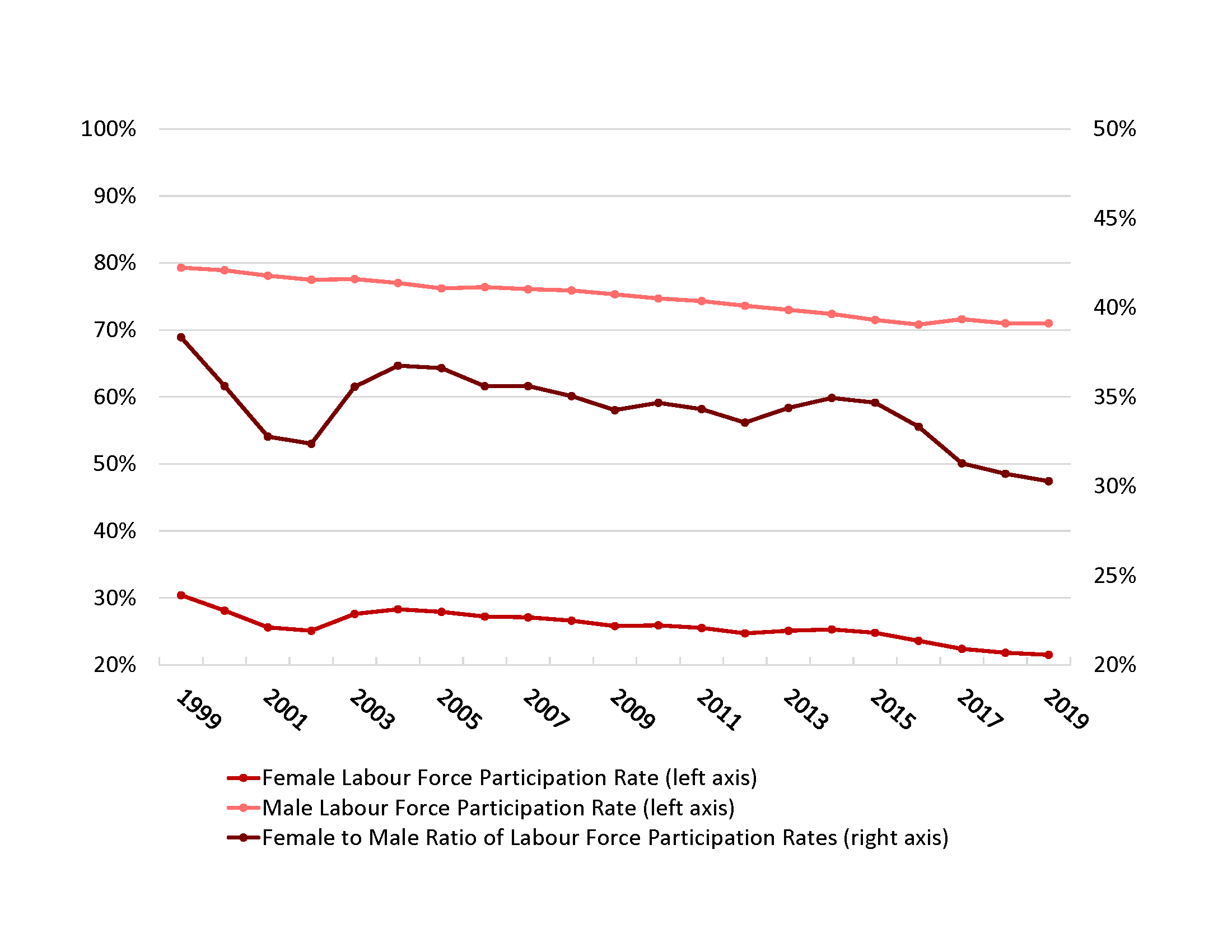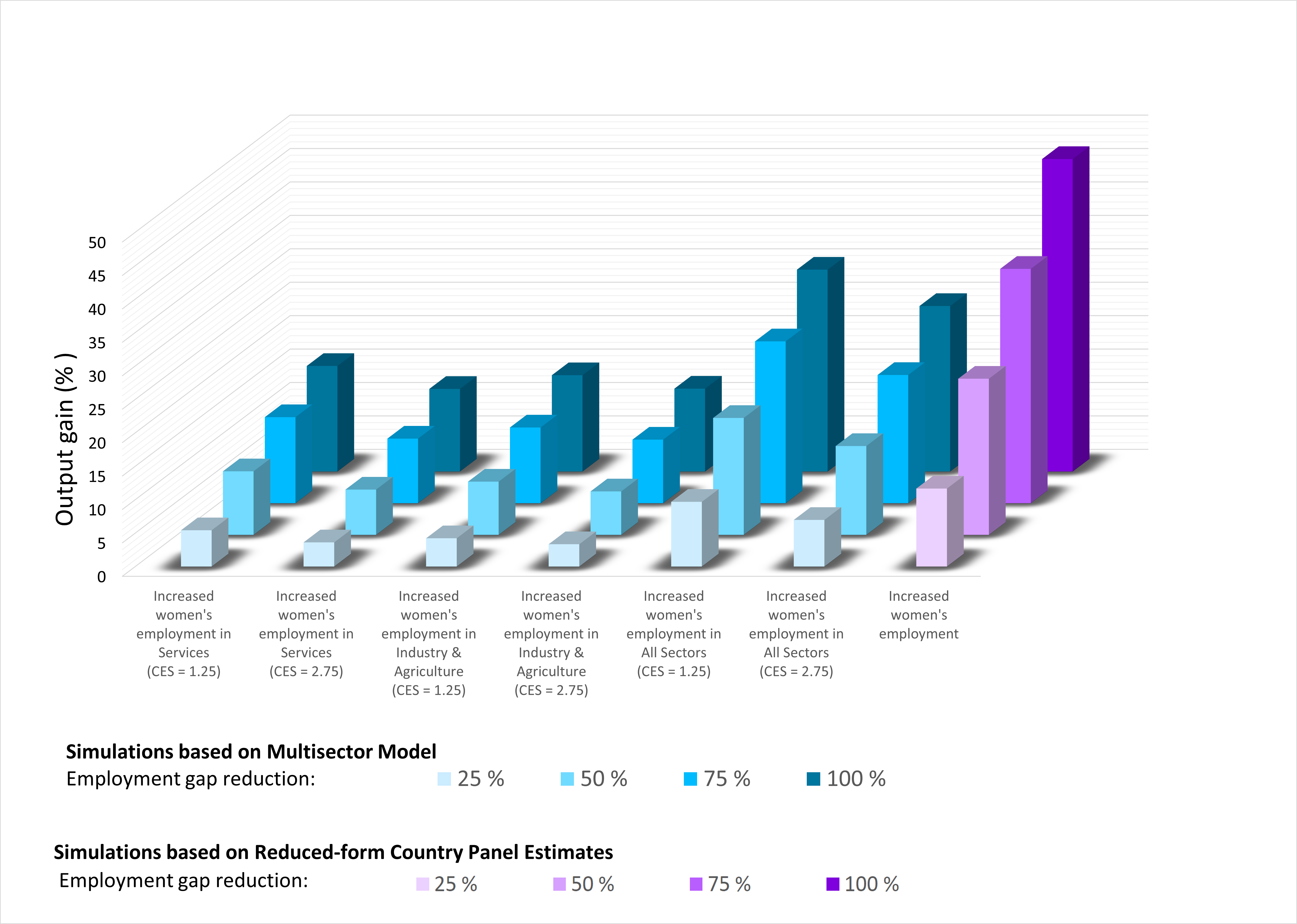Policy Brief
The economic gains of reducing the employment gender gap in Morocco
Middle East and North Africa (MENA) countries, including Morocco, currently record the lowest rates of female labour force participation (FLFP) in the world. These rates — between 20-30% in 2019 — appear substantially low in comparison to Western countries, but also compared to low- and middle-income countries that average between 40% (Asia) and 55% (Latin America and sub-Saharan Africa).
Women’s economic participation in Morocco remains low and has not improved since the 1990s
Reducing the gender gap in employment can improve macroeconomic performance in addition to women’s well-being and gender equity
Simulations show that reducing the gender gap by 25% would increase GDP by 7-12%, while reducing the gender gap to levels achieved in OECD countries could increase GDP by more than 25%
Data from the Morocco National Employment Surveys reveals that the women’s participation rate in 2019 was around 22%, compared to 71% for men.1 There has been a downward trend in employment for both men and women, but the reduction has been strongest for women. This is clear in the declining ratio of female-to-male rates, especially since 2015 (see Figure 1).
Simulations show that even a modest reduction in the gap between men’s and women’s participation in the labour market can lead to a significant increase in GDP in Morocco.
Why is Morocco’s female labour force participation so low?
The low participation of women in the labour market is explained by a set of obstacles: gender norms, the legal framework, the structure of the economy and of the labour market, and the distribution of human capital. Census data shows that demographic factors, such as marriage and the socio-economic status of the spouse, significantly determine women’s economic participation in urban areas. Family constraints, related to marital status and the number of children, are some of the most significant obstacles to women’s decisions to enter the labour market.
International comparisons also show that Morocco underperforms in terms of women’s employment relative to its development level. Reasons include social norms (women’s traditional place in society), and a relatively slow pace of structural transformation of the economy that has limited expansion in sectors which have proved essential to increasing female employment in other countries, such as manufacturing and services.
Figure 1: Labour force participation rates in Morocco, by gender

Source: Authors’ elaboration based on Morocco National Employment Surveys, High Commission for Planning (HCP).
Why more women working brings economic gains
A growing body of research shows that women’s underrepresentation in the labour market has detrimental effects in terms of reduced economic growth, through for instance reductions in women’s take-home earnings and bargaining power at home. Increased bargaining power has several potential growth effects, including larger investments in children’s education and health.
New evidence indicates that increasing women’s participation in the labour market should boost economic output not only through the additional supply of labour, but also thanks to the added diversity of productive factors that more women in the workforce implies. Women bring new skills, different risk attitudes, and preferences, and they respond differently to incentives to the labour market. Women therefore provide complementary skills to men’s so that, beyond the benefits resulting from simply having more workers, increasing female participation in the labour market should increase output more strongly than an equivalent increase in male employment. The analysis shows that, in Morocco, the degree of complementarity between male and female labour is indeed quite substantial.
What are the economic gains of reducing the gender gap in employment?
Simulations were used to uncover the potential impact of various reductions in the gender gap on Morocco’s GDP. Two distinct approaches were followed. The first one used firm data and a multi-sector macroeconomic model. The second imputed results from country panel variation in economic growth and the relative employment of women. Figure 2 summarizes the results and illustrates the significant economic gains that result from increases in FLFP.
In both approaches, the orders of magnitude are similarly large. A one-quarter reduction of the employment gap between women and men in either the tertiary sector or the industry/agriculture sector would increase output by 4-5% of GDP. Considering all the sectors, a reduction by 25% in the gap can lead to a 7-12% increase in GDP. A closing of the gender gap to equivalent levels achieved in OECD countries — female participation of above 70% — could increase GDP between 25-47%.
Figure 2: Output gains in Morocco from reducing or closing its gender gap in employment: summary from different estimation approaches

Source: Simulations based on the Multisector Model are based on data from the Enterprise Surveys on the Investment Climate and Business Competitiveness in Morocco (ICBC), collected by the World Bank in collaboration with the Kingdom of Morocco and the High Commission for Planning (HCP).
Source: Simulations based on Reduced-form country panel estimates are based on data from World Development Indicators, Penn World Tables and ILOSTAT.
Achieving increases in female labour force participation
These results highlight the need for long-term reforms that increase women’s education and participation in the labour market. Because a significant part of the economic cost of the gender gap comes from human capital differentials, the first step to capturing the economic gains of greater equality is to increase the enrolment rate for women and limit school drop-outs. Policies such as cash transfer programmes conditional on daughters’ school attendance and a gender-sensitization of curriculum can play a fundamental role in tackling existing stigmas against women and in supporting women’s educational attainment.
Policies that increase the enrolment rate and limit school drop-outs for women are needed
These could include cash transfer programmes, conditional on daughters’ school attendance, and a gender-sensitization of curriculum (i.e. revising textbooks and teaching methods)
Policies which ensure the effective inclusion of women in the labour market and which support women in their work-life balance are instrumental to increasing women’s participation in the labour market
Female entrepreneurship should be encouraged through improved property rights and access to credit markets for women
Policies that ensure the effective inclusion of women in the labour market and support women in their work-life balance are needed. Last, female entrepreneurship should be encouraged by strengthening women’s rights to own and access financial property, credit, and other means of production (property, equipment, technology, knowledge, etc.).
 Join the network
Join the network